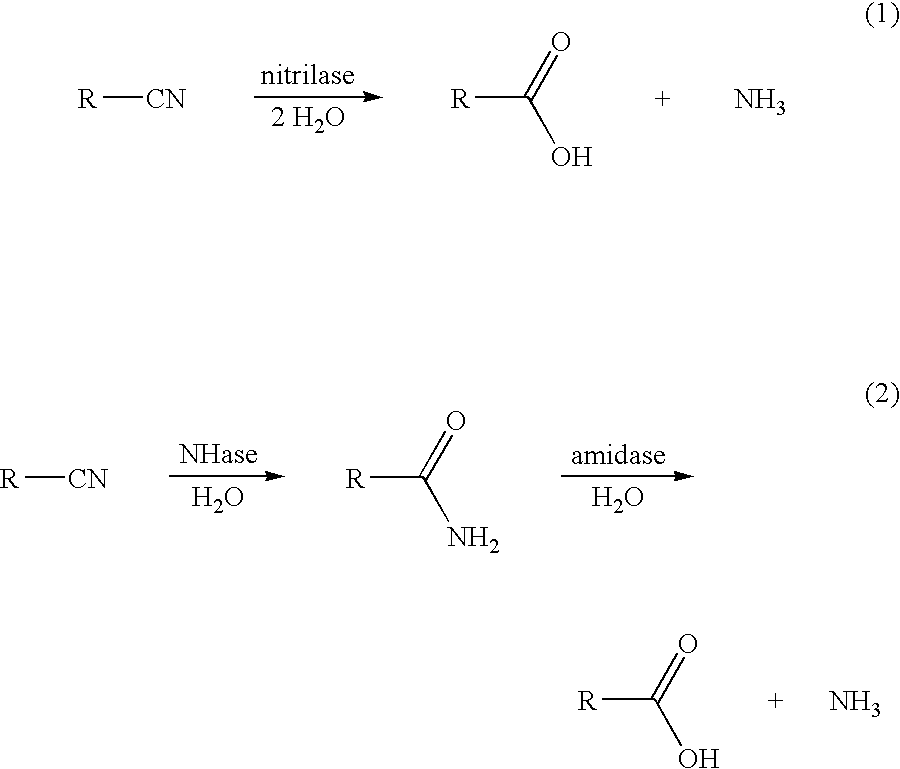Production of 3-hydroxycarboxylic acid using nitrilase
a technology of nitrilase and hydroxycarboxylic acid, which is applied in the field of microorganisms, can solve the problems of complex separation, and large amount of inorganic salts,
- Summary
- Abstract
- Description
- Claims
- Application Information
AI Technical Summary
Benefits of technology
Problems solved by technology
Method used
Image
Examples
example 1
Construction of A. facilis 72W Nitrilase Random Mutagenesis Libraries by Error-prone Polymerase Chain Reaction
[0124]Genomic DNA was prepared from A. facilis 72W (ATCC 55746) using a Puregene DNA isolation kit according to the manufacturer's instructions (Gentra Systems, Minneapolis, Minn.). Error-prone PCR was performed on the A. facilis 72W nitrilase gene (coding sequence; SEQ ID NO:3) using primers identified as SEQ ID NO:1 (5′-GCGCATATG GTTTCGTATAACAGCAAGTTCC-3′) and SEQ ID NO:2 (5′-ATAGGATCCTTATGGCTACTTTGCTGGGACCG-3′) according to instructions supplied with the GeneMorph PCR Mutagenesis Kit (Stratagene, La Jolla, Calif.). Reaction conditions recommended to produce a low mutation frequency (0–3 mutations / kb) and a medium mutation frequency (3–7 mutations / kb) were employed. Ten percent of the 1.1 kb PCR product was ligated into the expression vector pTrcHis2 TOPO according to instructions supplied with the pTrcHis2 TOPO TA Expression kit (Invitrogen, Carlsbad, Calif.). One half of...
example 2
Screening A. facilis 72W Nitrilase Random Mutagenesis Libraries for Increased Nitrilase Activity
[0126]Approximately 5,000 colonies from each of the error-prone PCR libraries were plated on LB agar supplemented with 50 mg / L ampicillin. High throughput screening was performed in 96-well microtiter plates using robotics. After growth of individual colonies in liquid LB supplemented with 50 mg / L ampicillin and 1 mM IPTG for 18 h at 37° C., 200 rpm shaking, cultures were supplied with 10 mM 3-hydroxyvaleronitrile (3-HVN) for 1 h at 37° C., 80 Hz linear shaking. Reactions were stopped by filtering out the bacteria, and supernatants to be analyzed were sealed in microtiter plates and stored at 4° C. until analysis. Production of 3-hydroxyvaleric acid (3-HVA) was measured by mass spectrometry (APCI-MRM, mobile phase 95% MeOH / 5% H2O at 5 mL / min; needle wash 50% MeOH / 50% H2O at 4 mL / min per needle). Three clones demonstrating 3-HVN conversion that exceeded the control (E.coli TOP10 / pNM18) by ...
example 3
Assay of E. coli TOP10 / pNM18 (Control), E. coli TOP10 / pNM18 / B4, E. coli TOP10 / pNM18 / B2 and E. coli TOP10 / pNM18 / H9 for Nitrilase Activity
[0127]Inoculum was prepared by adding 50 mL of LB media containing 50 mg / L ampicillin to sterile 125 mL flasks, then scraping frozen cell stock into the flask and incubating the resulting mixture at 37° C. and 200 rpm for 12 to 16 h. The optical density of the resulting culture was recorded, then 80% glycerol in water was added to a final concentration of 15% (v / v), and 14.3 mL aliquots of the resulting inoculum added to 50-mL centrifuge tubes and stored frozen at −80° C. until used. To a 4-L sterile flask was added 1.80 L of LB broth, 0.9 mL of an aqueous solution of ampicillin (100 mg / mL) and 1.8 mL of an aqueous solution of IPTG (1.0 M). To the flask was then added 87.5 mL of E. coli TOP10 / pNM18 (control), E. coli TOP10 / pNM18 / B4, E. coli TOP10 / pNM18 / B2 or E. coli TOP10 / pNM18 / H9 inoculum, the contents of the flask mixed, and 250-mL aliquots of the...
PUM
| Property | Measurement | Unit |
|---|---|---|
| pH | aaaaa | aaaaa |
| weight | aaaaa | aaaaa |
| weight | aaaaa | aaaaa |
Abstract
Description
Claims
Application Information
 Login to View More
Login to View More - R&D
- Intellectual Property
- Life Sciences
- Materials
- Tech Scout
- Unparalleled Data Quality
- Higher Quality Content
- 60% Fewer Hallucinations
Browse by: Latest US Patents, China's latest patents, Technical Efficacy Thesaurus, Application Domain, Technology Topic, Popular Technical Reports.
© 2025 PatSnap. All rights reserved.Legal|Privacy policy|Modern Slavery Act Transparency Statement|Sitemap|About US| Contact US: help@patsnap.com

